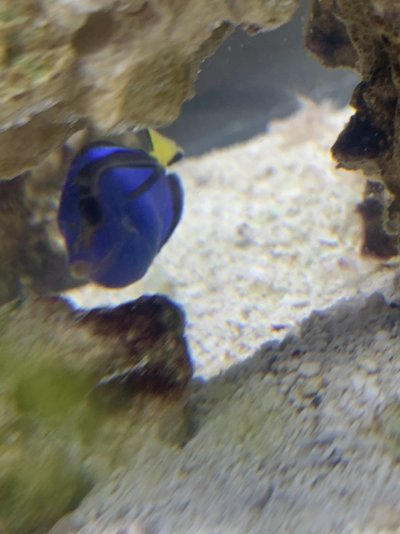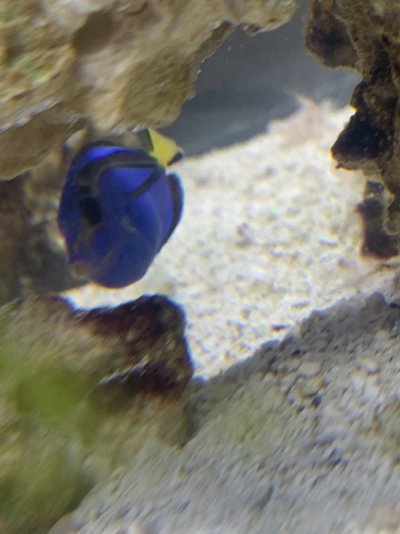Any idea what this could be? Have bad this little baby Blue Hippo Tang for a month know. Been thriving, already was in copper and such at the Place I got him from. He’s also tank raised. Still hitting and active instead of just hiding in the rocks at night. Is he just scraping himself or is it velvet? I’ve been advised that it isn’t Ick but looking for a second or third opinion!

Navigation
Install the app
How to install the app on iOS
Follow along with the video below to see how to install our site as a web app on your home screen.

Note: This feature currently requires accessing the site using the built-in Safari browser.
More options
You are using an out of date browser. It may not display this or other websites correctly.
You should upgrade or use an alternative browser.
You should upgrade or use an alternative browser.
Urgent Question
- Thread starter coreywithak
- Start date
threebuoys
Valuable Member
- Review score
- +0 /0 /-0
Partner Member 2023
Hospitality Award
Fish Medic
I assume you are asking abut the blemishes along the top of his head leading towards his nose?
How long has this condition been visible?
The photo is fuzzy, however, this looks like head and lateral line erosion (HLLE) to me. Tangs are susceptible to HLLE. The good news is HLLE is not contagious. The bad news is the scars do not heal. Often attributed to less than optimal water conditions and lower grade activate carbon being used. See stickies and articles authored by Jay Hemdal for more info.
Additional photos with better focus/sharpness will help to confirm HLLE and rule out other possibilities.
How long has this condition been visible?
The photo is fuzzy, however, this looks like head and lateral line erosion (HLLE) to me. Tangs are susceptible to HLLE. The good news is HLLE is not contagious. The bad news is the scars do not heal. Often attributed to less than optimal water conditions and lower grade activate carbon being used. See stickies and articles authored by Jay Hemdal for more info.
Additional photos with better focus/sharpness will help to confirm HLLE and rule out other possibilities.
Upvote
0
Yes, that’s what I’m referring to. I’ll do my best to get a better picture when I can but the small one is just swimming and doing his own thingI assume you are asking abut the blemishes along the top of his head leading towards his nose?
How long has this condition been visible?
The photo is fuzzy, however, this looks like head and lateral line erosion (HLLE) to me. Tangs are susceptible to HLLE. The good news is HLLE is not contagious. The bad news is the scars do not heal. Often attributed to less than optimal water conditions and lower grade activate carbon being used. See stickies and articles authored by Jay Hemdal for more info.
Additional photos with better focus/sharpness will help to confirm HLLE and rule out other possibilities.
Yes, that’s what I’m referring to, I may have another photo that’ll be a bit better, if not l’ll have to get a better photo of him later today. The small one has developed such a fun personality, and is quite hard to take a clearer photo of, always on the move. It does look as if it’s around it’s mouth too. I’m unsure if that’s also HLLE. When I got him and went to pick him, it was noticeable but was told he was just lodging itself’s in the rocks and scratching itself. Was about the size of a dime, now it’s a bit bigger, eating flakes, seaweed, and frozen mysis shrimp, mainly. If it is HLLE is there a way to treat this, anything else I should be looking out for?I assume you are asking abut the blemishes along the top of his head leading towards his nose?
How long has this condition been visible?
The photo is fuzzy, however, this looks like head and lateral line erosion (HLLE) to me. Tangs are susceptible to HLLE. The good news is HLLE is not contagious. The bad news is the scars do not heal. Often attributed to less than optimal water conditions and lower grade activate carbon being used. See stickies and articles authored by Jay Hemdal for more info.
Additional photos with better focus/sharpness will help to confirm HLLE and rule out other possibilities.
Attachments
Upvote
0
Yes, that’s what I’m referring to, I may have another photo that’ll be a bit better, if not l’ll have to get a better photo of him later today. The small one has developed such a fun personality, and is quite hard to take a clearer photo of, always on the move. It does look as if it’s around it’s mouth too. I’m unsure if that’s also HLLE. When I got him and went to pick him, it was noticeable but was told he was just lodging itself’s in the rocks and scratching itself. It’s just looked to spread a bit more. Was about the size of a dime, now it’s a bit bigger, eating flakes, seaweed, and frozen mysis shrimp, mainly. If it is HLLE is there a way to treat this, anything else I should be looking for? Also have someone that comes and monitors the tank every couple days as we have a new aquarium in the works. However, everything’s been monitored as I’ve said. Everything is said to he looking great. Only tank mates he’s with at this moment are a pair of clownfish that have spawned and 3 zebra hermit crabs.
Upvote
0
Upvote
0
Jay Hemdal
10K Club member
- Review score
- +0 /0 /-0
Staff member
Forum Moderator
Partner Member 2023
R2R Supporter
R2R Excellence Award
Expert Contributor
Article Contributor
Fish Medic
- Joined
- Jul 31, 2020
- Messages
- 19,471
- Reaction score
- 19,602
- Review score
- +0 /0 /-0
- Location
- Dundee, MI
It does look like HLLE. If the fish is eating well, not breathing fast and behaving normally, that is all that it is (sometimes a fish can show HLLE, but also have another issue at the same time). Here is an article about it:
Head and Lateral Line Erosion (HLLE)
This article discusses studies performed regarding head and lateral line erosion in captive fishes. Specifically, carbon use and nutrition as they relate to this syndrome.
 www.reef2reef.com
www.reef2reef.com
Jay
Upvote
0
threebuoys
Valuable Member
- Review score
- +0 /0 /-0
Partner Member 2023
Hospitality Award
Fish Medic
BTW, welcome to R2R! Glad to,see you found us, sorry it was due to an issue. Jay's article will explain all the details.
Upvote
0
vetteguy53081
Well known Member and monster tank lover
- Review score
- +12 /0 /-0
Partner Member 2023
R2R Supporter
R2R Excellence Award
Reef Tank 365
Article Contributor
Tampa Bay Reef Keepers
West Palm Beach Reefer
Hospitality Award
Ocala Reef Club Member
305 Reef Club
Wisco Reefers
Midwest Reefer
Fish Medic
MAC of SW Florida
R2R Secret Santa 2022
This is facial erosion known as HLLE which cause pits and flesh missing mainly in tangs, angels and some rabbitfish. It is often caused by poor water quality, high use of carbon, poor water quality (elevated nitrate and ammonia) and inadequate/poor diet. It is not life threating in any way but offers secondary infection in some cases.
Maintaining GOOD water quality and diet are often the fixes and with severe cases, some healing.
Some foods to feed tang are :
LRS herbivore diet
Formula 2 flake and frozen
TDO Pellets
small plankton
Hikari Marine cuisine
Ocean nutrition veggie diet
spirulina brine shrimp
mysis shrimp
Prime reef
Nori seaweed basted with garlic extract
Add selcon vitamins to foods occasionally
Last edited:
Upvote
0
Similar threads
- Replies
- 21
- Views
- 542
- Replies
- 4
- Views
- 227
- Replies
- 8
- Views
- 157
- Replies
- 4
- Views
- 174
- Replies
- 5
- Views
- 353











